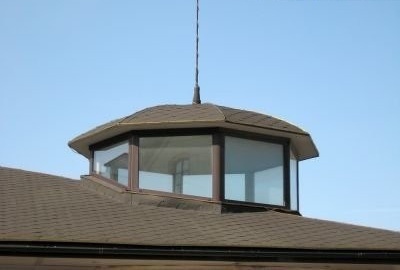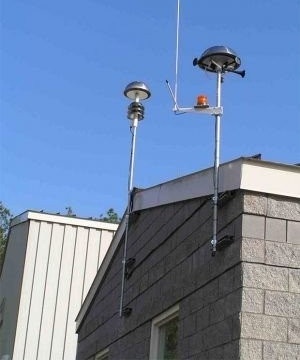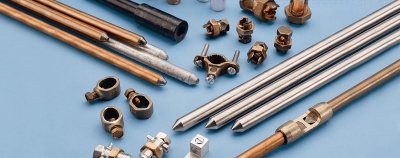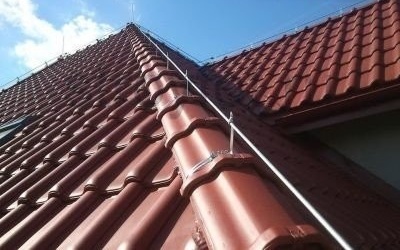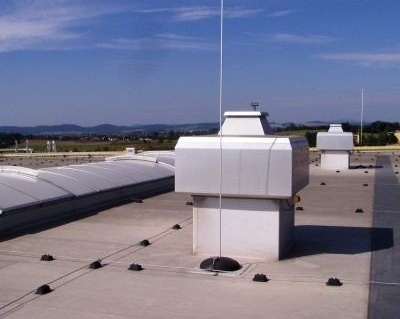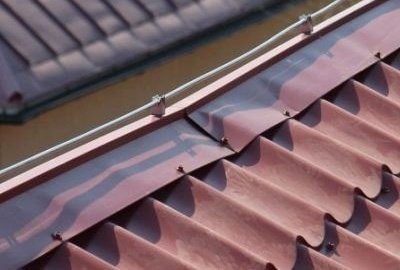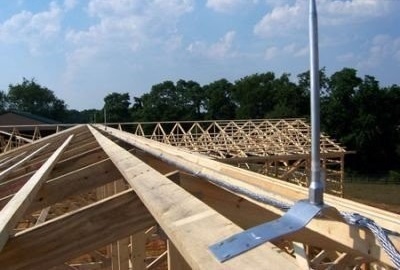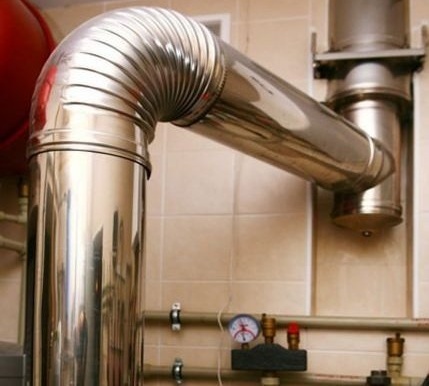How to protect your home from lightning: do bends
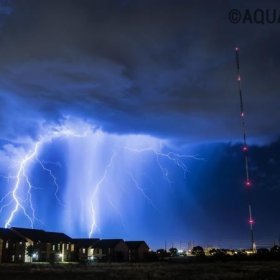
In order to protect the house from destruction and fire arising from lightning entering the building, people have long used lightning rods. In large cities, construction and specialized organizations do this. In rural areas, especially near ponds and marshes, on hills and open spaces, the risk is no less, so you should take care to protect the building in advance. Moreover, the lightning protection device does not require large expenses, and the benefit is obvious.
Content
Why is lightning protection at home
According to research by meteorological services, for every square kilometer of the territory of the Russian Federation, on average, two to three lightning strikes per year occur. In 25% of cases, a celestial electric discharge is accompanied by damage to various objects. This is due to the fact that the temperature at the point of application of the discharge can reach 30,000 degrees. The voltage and current indicators are very high: up to 150 million volts and 200 thousand amperes. And although the effect of lightning is short-lived, materials that support combustion flash instantly. And since the storms are accompanied by strong winds, the likelihood of a fire increases exponentially.
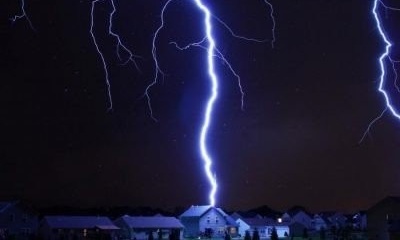
For each square kilometer of the territory of our country, on average, two to three lightning strikes per year
Usually, means to protect a house from lightning are called a lightning rod, but this is not an exact definition, since thunder is just the sound accompaniment of lightning discharges. A more precise wording is lightning protection. It reflects the essence of the device and is accepted among specialists working in this area of security.
In order to protect the building from lightning strikes, there are devices that are based on one of the laws of electrostatics. During a thunderstorm, a high potential charge of ions accumulates in the atmosphere. It has a positive meaning. The earth always has a negative charge.When the potential difference reaches a critical value, the air gap between them breaks through a giant spark, which is called lightning.
To prevent a lightning strike in the building, a lightning rod is installed on it, directing current to the ground, bypassing the building. This is achieved using materials having a conductivity higher than the roofing.
Lightning protection structure
Lightning rods come in two varieties - passive and active.
Passive Lightning Protection
Passive lightning protection is the most common and traditional type used in all countries of the world. In domestic legislation is regulated by the standard RD 34.21.122–87 - “Instructions for lightning protection of buildings and structures”.
In accordance with this document, lightning protection by quality indicators is divided into four categories in descending order. That is, the first category is the highest, the fourth is the minimum allowable. The category depends on the density of the air terminal per square meter of roof area.
Active lightning protection
Active lightning protection appeared relatively recently - in the mid-80s of the last century. Its essence lies in the fact that in place of a conventional spire a device is placed that attracts the discharge onto itself. It has smaller dimensions and works due to the forced ionization of air. This, according to manufacturers, allows you to artificially cause a lightning discharge at earlier stages, when the potential difference is relatively low. The advantage is that discharges occur more often, but with less force.
Structurally, air ionization is carried out either by specialized electronic circuits or by arrester, acting at the time of increasing the total electric field voltage in the pre-thunderstorm atmosphere.
The external difference of such lightning rods lies in the fact that the antenna is mounted with characteristic metal bowls, shaped like a flying saucer.
There are no provisions in domestic regulatory legislation governing the installation of active lightning protection. This is due to the fact that most experts in this field are very skeptical about the effectiveness of this type of protection against lightning. Many cases have been described and recorded when discharges of electricity did not hit the antenna, but nearby, thereby endangering the building.
Lightning protection design and device
All parts of lightning rods are made of metal - copper, aluminum or steel. Only the fasteners with which the conductors are attached to the surface of the roof or wall should be dielectric. The classic lightning protection device circuit consists of three main parts:
- lightning rod;
- down conductor;
- grounding.
Lightning rod
The air terminal is installed on the roof of the building and serves to catch the electric discharge. In some rare cases, the air terminal is not installed on the roof itself, but in close proximity, for example, on a nearby mast of a television antenna or a tall tree.
Lightning rods are:
- pivotal;
- cable;
- mesh.
Rod lightning rod
Rod structures are the most common in the private sector and are easy to install. It is believed that the higher the lightning rod antenna, the more space it protects. There is a formula for the approximate calculation of the height of the air terminal.
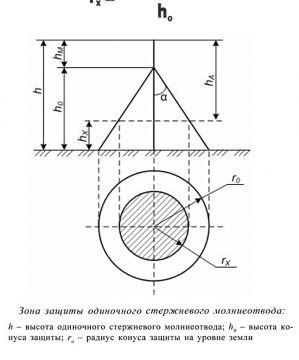
You can calculate the sufficient height of the air terminal antenna yourself or using the online calculator
Imaginary cone with a vertex at the end of the air terminal antenna and a side angle of 90about covers an area that is safe.
Usually in private homes, the height of the air terminal antenna ranges from 0.5 to 2 meters. Ready-made antennas are on sale, but you can make it yourself. It can be a copper round bar with a section from 35 mm2, steel reinforcement with section from 65 mm2 or a galvanized water pipe sealed at both ends.
If the roof of the building has a complex configuration, sometimes several antennas are used. This is done so that at a lower height, the protective coating is large.
The antenna mount must be reliable and not come in contact with the metal part of the roof surface. The base of the mount must have dielectric properties.
Cable lightning rod
The cable lightning rod is convenient in that its installation is not associated with complex high-altitude work. The cable is installed along the axis of the ridge at a height of 15–20 cm. The cable thickness is recommended at least 6 mm. It is mounted on metal or wooden racks, its sagging or rocking by the wind is unacceptable. The cable stretches like a string.
Mesh air terminal
The metal mesh in the role of an air terminal is most often used in apartment buildings with a flat roof, shopping centers and in the private sector. There are certain features of installing a mesh air terminal on a flat roof:
- the mesh is laid on a concrete floor and covered with heat insulating materials. A prerequisite for this is the incombustibility of such coatings;
- installation is carried out on top of the roof, the grid is exposed on plastic supports to a height of 10-15 cm.
The choice of one or another option depends on the design basis. More often the external styling method is used.
A mesh is made of a metal conductor with a cross section of 6 mm or from rectangular strips of metal measuring 20x4 mm. In accordance with international standards, the distance between the wires should not exceed 12 meters in the residential sector, and 5 meters in the non-residential. The perimeter of the building is covered by a contour conductor, and the connections between the metal strips are fastened with bolts or welding. Cells are evenly distributed over the entire area. If the roof is metal and the thickness of the metal is less than 4 mm, the air terminal is installed on special stands. The mounting height should ensure the absence of a spark gap.
Down conductor
A down conductor is an important intermediate element of lightning protection between an air terminal and ground. Serves for the transmission of electrical discharge. Therefore, taking into account large quantities of current, it is made in the form of an all-metal conductor 6 mm in diameter or in the form of a bus 4 × 20 mm in size.
The upper end of the down conductor is welded or bolted to the lightning rod, the lower end is attached in the same way to ground. The middle part goes along the wall, while the lower 2.5–3 meters are recommended to be placed in an insulating cable channel or corrugation. This will create additional protection from lightning to a person standing nearby. According to regulatory documents, the distance between the down conductors should not be less than 25 meters, if possible, they should be laid without approaching the windows and entrance doors. Do not lower the down conductor along the corner of the wall.
An important condition for installing a collector busbar is a ban on kinks of more than 90about and ring formation. In such places spark lumbago may occur, subsequently leading to fire. When connecting the parts of the collector to each other, it is recommended to use welding.If the connection is broken, a high-temperature electric arc can form with all the ensuing consequences. The basic rule for laying a down conductor is to descend to the ground along the shortest distance.
Sometimes to disguise the conductor, it is mounted under a drain. But in no case can you attach the tire to the tin surface of the gutter.
Grounding
Grounding is the final destination of an electrical discharge. In order for the ground electrode to work properly, the soil composition in which it is located should be taken into account. The best option is considered to be raw soil, which has good electrical conductivity. Dry sand is considered the worst: in this case, it is necessary to increase the ground area.
Of no small importance is the material from which the grounding is made. Low alloy steels corrode quickly enough and, when they rot, sharply reduce the degree of electrical conductivity. Galvanized iron does not protect against the appearance of rust. Over time, in moist soil, such grounding turns into rusty dust. The most suitable are copper and stainless grounding, their service life can be very long.
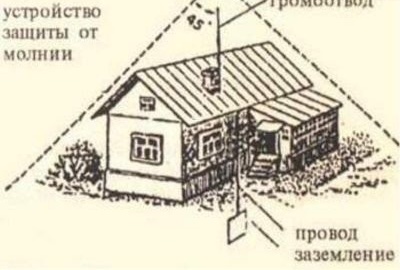
The soil in which it is placed must be moist because the moist soil has good electrical conductivity
There are several ways to organize grounding. Each of them has its advantages and disadvantages.
- It can be metal pipes or corners driven to a depth of 2-3 meters, a channel or an I-beam dug in. All grounding elements are interconnected either by a corner or by a metal bus. Due to this, the area of contact between the ground electrode system and the soil increases, which leads to high-quality "utilization" of the lightning discharge.
- In private housekeeping, they often dig an iron barrel or sheet of thick stainless steel into the ground.
- Sometimes they use large pieces of welded metal mesh, digging it to a depth of 1 meter.
To increase the electrical conductivity of dry soil, salt or potassium nitrate is poured into deep holes. Being a good conductor and gradually dissolving in the ground, salt also retains moisture around it. This procedure can be carried out once every several years.
The main rule for installing grounding is that it cannot be positioned closer than 5 meters from the front door, porch or terrace. The same distance must be maintained from playgrounds, paths and aviaries with animals. The minimum allowable distance to the walls of the house is 1 meter.
Video: lightning protection grounding device
Lightning protection prevention and maintenance
Like any technical construction, lightning rods require careful attention. In doing so, pay attention to the following details.
- Serviceability of all types of fastening. Every few years, it is necessary to check all threaded connections, tighten the loosened bolts and nuts. After frequent thunderstorms, joints connected by welding should be inspected for a break.
- At least once every five years, conduct a thorough grounding inspection, monitor the degree of metal corrosion. Use a tester to measure the electrical resistance of the ground electrode.
DIY installation features of an air terminal
Despite the apparent complexity of installing lightning-trapping equipment, it is possible for each person who carefully reads the above recommendations to independently calculate and install a home lightning rod. It is only necessary to have a simple tool and the necessary materials.
Conventionally, the whole process can be divided into 5 stages.
Material calculation
The main thing is to choose the height of the lightning rod antenna correctly. When calculating the length of the boom, you can use the well-known proportion: the mast height is equal to one and a half the radius of the protected area.
For example, if the diameter of the circle in which the house stands is 20 meters, then one and a half radius will be 10x1.5 = 15 m. Subtract the height of the house from this value and get the desired value. For example, if the structure is 10 meters high, then subtracting them from 15 meters, we get the desired lightning protection spire size - 5 meters.
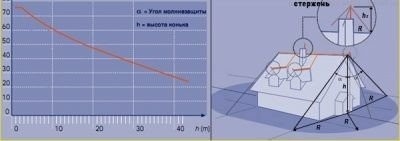
The height of the air terminal mast should be equal to one and a half values of the radius of the protected area
The length of the down conductor is calculated based on the parameters and configuration of the route that was planned. The earthing switch and all associated fasteners are planned in accordance with their location.
Installing the receiver in a suitable location
When installing an air terminal antenna, the roof structure, the location of combustible structural elements, the location of doors and windows, drainpipes and other metal elements are taken into account.
Laying down conductors from mast to ground
Guided by the connection rules, they carry out a complete assembly of the entire section, including the insulation of the wire in the corrugation at the last 2.5-3 meters from the ground. When bolted, it is recommended that hardened grovers be placed under the nuts and washers under the bolt heads. If welding is used, it is necessary to carefully descale and paint the joint with weather-resistant paint or varnish.
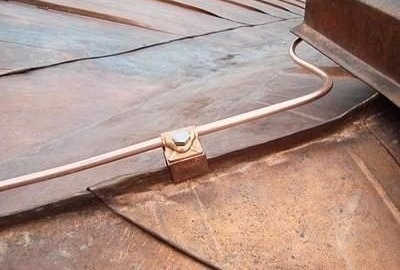
It is better to hide the lower 2-3 meters of the down conductor in an insulating cable channel or corrugation
Down conductor connection
The busbar is connected to a pre-prepared ground loop. Both welding and threaded joints and rivets can be used.
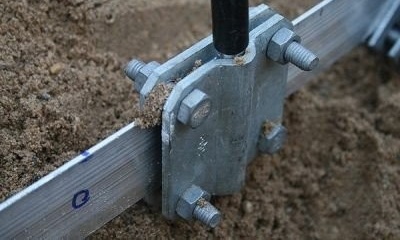
Ground connection
"Width =" 400 ″ height = "267 ″ />
The down conductor is connected to the ground loop by welding, threaded connections or rivets
Resistance test
Using a tester or multimeter, the electrical resistance of the mounted device is measured, which should not exceed 10 ohms.
Video: installation of lightning protection of a private house
Not the last role in the safety of the house is played by protection against natural disasters. The correct installation of lightning protection will give a long-term and guaranteed result. It will protect the building from possible fires or electric shock to residents. Timely preventive maintenance will help to serve the device for a long time.
